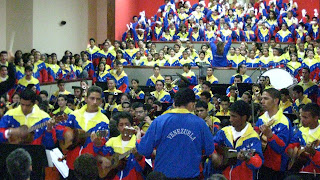 The Caracas Centro de Acción Social por la Música is the first of what will be seven nation-wide centers in Venezuela. The Centro ("la sede" as they call it) doesn't house a program per se, but you can say is the headquarters for most of the larger ensembles and the venue for several events, like seminarios, master-classes, courses and concerts. Although the first phase of the complex has not been yet officially open, the center is almost at full use. There we had the opportunity to attend concerts, open rehearsals and private presentations by some of the top ensembles in Caracas: The Simón Bolivar "A" (Senior) Orchestra under Gustavo Dudamel, Simón Bolivar "B" (Youth) Orchestra under Claudio Abbado, Teresa Carreño Youth Orchestra, Caracas Youth Orchestra, the Caracas Youth Choir and the Caracas Children's Choir.
The Caracas Centro de Acción Social por la Música is the first of what will be seven nation-wide centers in Venezuela. The Centro ("la sede" as they call it) doesn't house a program per se, but you can say is the headquarters for most of the larger ensembles and the venue for several events, like seminarios, master-classes, courses and concerts. Although the first phase of the complex has not been yet officially open, the center is almost at full use. There we had the opportunity to attend concerts, open rehearsals and private presentations by some of the top ensembles in Caracas: The Simón Bolivar "A" (Senior) Orchestra under Gustavo Dudamel, Simón Bolivar "B" (Youth) Orchestra under Claudio Abbado, Teresa Carreño Youth Orchestra, Caracas Youth Orchestra, the Caracas Youth Choir and the Caracas Children's Choir.
You can say that the center is becoming the "open source" hub for the exchange of information and knowledge for whoever lives in or comes to Caracas. That is actually one of the roles of a núcleo, in general, but at the center, all the top of the line resources must be in place: technology, state of the art acoustics, practice rooms, rehearsal and concert halls that are adequate to the complex social and artistic mission of El Sistema ("Culture for the poor should not be poor culture" –José Antonio Abreu).
 During our visit, world renowned clarinetist Luis Rossi was giving a series of master classes. This was part of what the call in Venezuela the "academies". All advanced and/or promising musicians, of any age, are accepted to be part of their instrument's academy. This gives these musicians from all over the country an opportunity to participate in periodical master-classes with the top teachers in Venezuela, and also with visiting artists and teachers, such as Mr. Rossi. But to me what's most important, is that the academies are another way in which musicians from all over the country, from different levels and ages –all clarinetists in this case– have a chance to meet and catch up with each other's news, ideas, progress and challenges, all while playing music together or to each other.
During our visit, world renowned clarinetist Luis Rossi was giving a series of master classes. This was part of what the call in Venezuela the "academies". All advanced and/or promising musicians, of any age, are accepted to be part of their instrument's academy. This gives these musicians from all over the country an opportunity to participate in periodical master-classes with the top teachers in Venezuela, and also with visiting artists and teachers, such as Mr. Rossi. But to me what's most important, is that the academies are another way in which musicians from all over the country, from different levels and ages –all clarinetists in this case– have a chance to meet and catch up with each other's news, ideas, progress and challenges, all while playing music together or to each other.
Not all the instruments have an academy yet (the percussionists are working on it, for instance, and there seems to be some new initiatives for the violas), but the model has been set and proven successful. The idea of connections happening at all levels and all directions won't happen spontaneously (And I will be repeating this a lot). In Venezuela, Maestro Abreu has developed the basic framework for this connections to happen: Núcleos are the basic form: they are always open to new students, new teachers and guests form all places, ages, educational, economic and social situations. But also simpler forms of "connectors" like the módulos and now, more sofisticated venues like the 7 centers follow the same openness and exchange principle. Seminarios (camps), tours, and academies could be called "event-based connectors".

FESNOJIV is in the last stages of the competition for the expansion of the current Centro de Acción Social por la Música building. The idea is to have more practice and rehearsal rooms. Also in the works, is the selection of the designs for the other 6 centers in Venezuela. Rumor has it that a celebrated American architect, who's now buddies with Gustavo Dudamel is going to design the center at Gustavo's home town, Barquisimeto.
But, what is significant is the amount of high quality information and knowledge exchange the connections within a center will provide. If so far, núcleos and módulos that in most cases function in inadequate venues have produced a 35 year long music program as El Sistema, just imagine the big push (artistically and socially) that 7 new state of the art centers will give to it. If you think (like we usually hear) "but we have good state of the art venues, that's no news", I'd say "think open sources". Connect, share, include.


.jpg)




